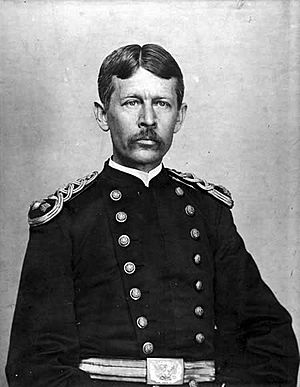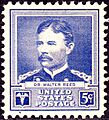Walter Reed facts for kids
Quick facts for kids
Walter Reed
|
|
|---|---|

Walter Reed
|
|
| Born | September 13, 1851 Gloucester County, Virginia, U.S. |
| Died | November 23, 1902 (aged 51) Washington, D.C., U.S. |
| Buried | |
| Allegiance | |
| Service/ |
|
| Years of service | 1876–1902 |
| Rank | Major |
| Alma mater | University of Virginia New York University Johns Hopkins University |
| Spouse(s) | Emilie Lawrence (m. 1876) |
| Children | Walter Lawrence Reed (born December 4, 1877, Ft. Apache) Emilie Reed (called Blossom) (born July 12, 1883, Ft. Omaha) Susie Reed (adopted aboriginal American child) |
Walter Reed (September 13, 1851 – November 22, 1902) was an important doctor in the U.S. Army. In 1901, he led a team that proved a big idea from Cuban doctor Carlos Finlay. They showed that yellow fever is spread by a special type of mosquito, not by touching sick people.
This discovery was a huge step forward for understanding how diseases spread. It also helped the United States finish building the Panama Canal (1904–1914). Before Reed's work, many workers got sick with yellow fever, making it very hard to build the canal.
Contents
Walter Reed's Early Life and Family
Walter Reed was born in Belroi, Virginia. His father, Lemuel Sutton Reed, was a traveling minister. Walter was the fifth child in his family. When he was young, his family lived in Murfreesboro, North Carolina, while his father traveled for work.
Walter was very smart and started college early. He went to the University of Virginia. He earned his first medical degree (M.D.) in 1869, when he was just 17 years old. He was the youngest person ever to get an M.D. from that university.
After that, he went to New York University and got a second M.D. in 1870. He then worked for the New York Board of Health. In 1876, Walter married Emily Blackwell Lawrence. They had a son, Walter Lawrence Reed, and a daughter, Emily Lawrence Reed. They also adopted a Native American girl named Susie.
Joining the U.S. Army Medical Corps
Walter Reed decided to join the U.S. Army Medical Corps in 1875. This gave him good job chances and a steady income to support his family. He passed a very tough exam to become an assistant surgeon.
For the next 16 years, the Army sent him to different places in the American West. He took care of soldiers, their families, and even Native American tribes, including some Apache people. He saw how quickly diseases could spread and worried about clean conditions. Later, he studied more about diseases at Johns Hopkins University.
Investigating Diseases
In 1893, Reed started teaching at the George Washington University School of Medicine in Washington, D.C. He taught about tiny living things (bacteriology) and how to look at them under a microscope. He also did his own medical research.
Reed first became well-known for his research in 1896. He proved that yellow fever among soldiers near the Potomac River was not caused by drinking river water. He showed that soldiers who got sick often walked through swampy woods at night. Officers who did not go into the woods did not get sick. This helped him understand how the disease spread.
Solving the Mystery of Yellow Fever
During the Spanish–American War, many U.S. soldiers in Cuba got sick with diseases like typhoid fever and yellow fever. In 1898, Reed helped investigate a typhoid outbreak. He and his team showed that it was caused by flies spreading germs from waste to food and drinks.
In May 1900, Major Reed went back to Cuba. He was put in charge of a team to study tropical diseases, especially yellow fever. At this time, people were just starting to understand that tiny germs caused diseases.
The Mosquito Connection
Reed's team, called the U.S. Army Yellow Fever Commission, made a huge discovery. They proved that yellow fever was spread by mosquitoes. They showed that it was not spread by touching clothes or bedding from sick people, which was a common belief.
They did dangerous experiments using human volunteers, including some of the medical staff. These volunteers allowed themselves to be bitten by mosquitoes that carried yellow fever. This research happened at Camp Lazear, named after Reed's assistant, Jesse William Lazear, who died from yellow fever during the project.
The findings from this research were quickly used in Panama. By getting rid of mosquitoes, they greatly reduced yellow fever during the building of the Panama Canal. Before this, yellow fever had stopped earlier French attempts to build the canal.
Giving Credit to Carlos Finlay
Even though Walter Reed got a lot of praise for his work, he always gave credit to Cuban doctor Carlos Finlay. Finlay was the first to suggest that mosquitoes carried yellow fever. He even identified the specific type of mosquito. Reed often mentioned Finlay in his writings and personal letters. Finlay's early ideas were the starting point for Reed's important research.
Walter Reed's Legacy and Impact
Walter Reed returned from Cuba in 1901. He continued to talk and write about yellow fever. For his amazing research, he received special honors from Harvard and the University of Michigan.
Sadly, Walter Reed died on November 23, 1902, at the age of 51. He had a burst appendix, which led to a serious infection. He was buried in Arlington National Cemetery.
A Lasting Impact on Medicine
Reed's discovery about yellow fever is seen as a major turning point in medicine. It opened up new ways to study diseases and help people. His work built on the ideas of Carlos J. Finlay, who first suggested in 1881 that a mosquito could carry the yellow fever germ.
This discovery helped another doctor, William C. Gorgas, greatly reduce mosquito-borne diseases in Panama. This was crucial for the American effort to build the Panama Canal starting in 1903. Before this, about 10% of the workers died each year from malaria and yellow fever.
Many places and institutions are named after Walter Reed to honor his contributions:
- The Walter Reed General Hospital in Washington, D.C., opened in 1909. It later became part of the Walter Reed National Military Medical Center in Maryland.
- The Walter Reed Army Institute of Research (WRAIR) near Washington, D.C., is the largest medical research center for the U.S. military.
- The Walter Reed Birthplace in Virginia is a historic site.
- Walter Reed Middle School in North Hollywood, California, is named in his honor.
Walter Reed's name is also on a special wall (frieze) at the London School of Hygiene & Tropical Medicine. This honors him as one of the pioneers in public health and tropical medicine. His story has also been told in plays and movies, like the 1938 film Yellow Jack.
Images for kids
See also
 In Spanish: Walter Reed para niños
In Spanish: Walter Reed para niños
- Human experimentation in the United States








